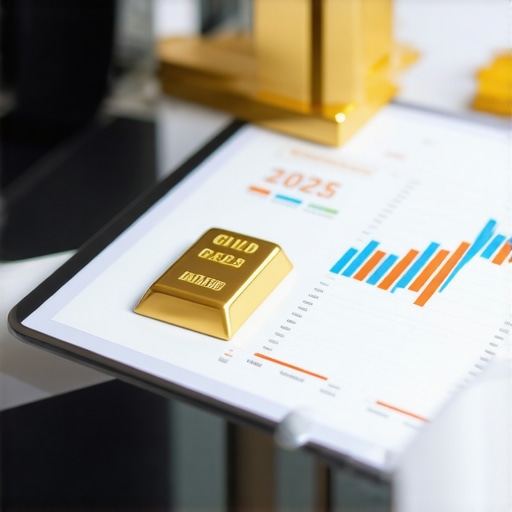Unveiling the Investment Dilemma: Gold ETFs Versus Mutual Funds
In the ever-evolving landscape of financial assets, investors often grapple with choosing the most rewarding avenue to grow their wealth. Among precious metals, gold stands out as a timeless hedge against inflation and market volatility. Yet, within gold investments, a pivotal question emerges: should one opt for Gold Exchange-Traded Funds (ETFs) or gold-focused mutual funds? Both instruments offer exposure to gold, but their structures, risk profiles, and return potentials differ significantly. This article dives deep into these differences, empowering investors with expert insights to make informed decisions that align with their financial goals.
The Intricacies of Gold ETFs: Direct Exposure with Liquidity
Gold ETFs have surged in popularity due to their simplicity and efficiency. These funds typically track the price of physical gold, offering investors near-instantaneous access to gold’s market price without the need to hold physical metal. The liquidity of Gold ETFs allows for real-time trading on stock exchanges, making them highly accessible for both retail and institutional investors.
From an expert perspective, Gold ETFs minimize management overheads and reduce the layers of intermediation, often resulting in lower expense ratios compared to mutual funds. Moreover, the transparency of holdings and pricing provides a straightforward correlation with gold’s spot price, an advantage for investors seeking pure exposure to the metal’s performance.
Gold Mutual Funds: Diversified Exposure Through Strategic Management
Conversely, gold-focused mutual funds invest not only in physical gold but also in mining companies, exploration firms, and other related assets. This diversified strategy can potentially amplify returns but also introduces higher volatility and stock market risk. Active management within mutual funds aims to capitalize on growth opportunities in the gold sector, which might outperform the metal price itself under certain market conditions.
However, these funds come with higher expense ratios due to active management fees and may carry additional risks linked to operational and geopolitical factors affecting mining companies. Investors must weigh these trade-offs carefully against their risk tolerance and investment horizon.
How Do Gold ETFs and Mutual Funds Compare in Yield and Risk Over Time?
Analyzing historical data reveals that Gold ETFs tend to provide steadier, more predictable returns closely aligned with gold prices, making them suitable for conservative investors. In contrast, gold mutual funds have exhibited periods of higher returns, particularly during bullish phases for mining stocks, but with increased drawdowns during downturns.
For instance, during the 2019–2020 market volatility, many gold mining mutual funds outperformed ETFs due to operational leverage and equity market rebounds. Yet, in more stable or declining gold price environments, ETFs often preserved capital more effectively.
Practical Considerations: Costs, Tax Efficiency, and Accessibility
Cost structures differ notably. Gold ETFs generally have lower management fees and incur fewer transaction costs due to their passive nature. Tax implications also vary; for example, in some jurisdictions, gains on physical gold ETFs may be taxed differently than mutual fund distributions, influencing net returns.
Accessibility matters too. ETFs enable intraday trading, margin purchases, and options strategies, adding layers of flexibility absent in mutual funds, which trade only once daily at net asset value.
For a detailed comparison and to explore top-performing options for 2025, investors can review comprehensive analyses at BuyingGoldNow’s expert guide.
Expert Insight: Aligning Investment Choice With Portfolio Goals
Seasoned investors often blend both Gold ETFs and mutual funds to balance direct metal exposure with growth potential from mining equities. This hybrid approach leverages the stability of ETFs while capturing upside from active management in mutual funds.
Understanding macroeconomic drivers, such as inflation trends, currency fluctuations, and geopolitical risks, is essential to timing and selecting the right gold investment vehicle. The World Gold Council provides authoritative research on gold market dynamics that can further inform strategic decisions.
If you found these insights valuable, feel free to share your thoughts or experiences in the comments below. Engaging with a community of knowledgeable investors can deepen understanding and uncover nuanced strategies tailored to your financial journey.
My Journey Navigating the Gold Investment Landscape
Reflecting on my own experiences investing in gold ETFs and mutual funds, I’ve come to appreciate how personal goals and market timing deeply influence outcomes. Early on, I favored gold ETFs because of their simplicity and the ability to react quickly to market changes. I recall a period during the 2020 market turmoil when owning gold ETFs helped me hedge against inflation fears effectively, providing a sense of security amid uncertainty.
However, as I grew more comfortable and sought higher growth, I gradually incorporated gold mutual funds into my portfolio. The exposure to mining stocks and exploration companies offered exciting upside potential that pure metal holdings couldn’t provide. Yet, it wasn’t without volatility—there were moments when geopolitical tensions or mining sector disruptions led to sharp pullbacks. These experiences taught me to combine both instruments thoughtfully rather than relying on one alone.
Balancing Risk and Return: A Personal Strategy
What’s struck me consistently is the importance of aligning investment choices with your risk appetite. My conservative side appreciates the steadiness of gold ETFs, especially when inflation signals rise or markets get jittery. Conversely, when I’m bullish on economic growth or commodity cycles, mutual funds have rewarded patience with impressive returns.
Research from the World Gold Council underscores these dynamics, showing how gold mining equities can outperform during certain commodity upswings but also carry amplified risks during downturns. This insight helped me tailor my portfolio depending on where we stand in the economic cycle.
Are You Considering Which Gold Investment Fits Your Financial Personality?
This is a question I often ask fellow investors. Are you someone who prefers hands-on control and quick trades? Or do you lean toward a managed, diversified approach with potential for greater returns but more risk? Your answer can guide whether Gold ETFs or mutual funds (or a mix) are better suited for your financial journey.
Practical Tips for Choosing Trusted Gold Dealers and Platforms
Another aspect I’ve learned is the critical importance of choosing reliable sources when buying gold, whether through ETFs, mutual funds, or physical gold investments. The market is flooded with options, but not all dealers and platforms are equally trustworthy.
For beginners and seasoned investors alike, I recommend checking resources like BuyingGoldNow’s guide on trusted gold dealers. It offers invaluable advice on verifying seller credentials, understanding pricing transparency, and ensuring secure transactions—key to protecting your investment.
Expanding Beyond ETFs and Mutual Funds: Exploring Other Gold Investment Avenues
Over time, I’ve also explored other gold investment options such as physical gold bars, coins, and even gold IRAs for retirement planning. Each vehicle has its nuances, and I found that combining them strategically can enhance portfolio resilience. For example, a physical allocation offers tangible security, while ETFs add liquidity and ease of trading.
If you’re curious about starting with physical gold but unsure where to begin, the step-by-step guide on buying gold bars is an excellent resource to help you buy safely and confidently.
Investing in gold is truly a personal journey shaped by your financial goals, risk tolerance, and market outlook. I invite you to share your experiences or questions in the comments below—let’s learn from each other’s journeys and make smarter gold investment decisions together.
Decoding Volatility Patterns in Gold ETFs Versus Mutual Funds: An Expert’s Perspective
Volatility remains a defining characteristic of any investment, particularly within the gold sector where multifaceted economic forces interplay. Gold ETFs, by design, offer volatility profiles tightly linked to the spot price of gold. This direct correlation means that abrupt macroeconomic shifts, such as Federal Reserve interest rate announcements or geopolitical turmoil, can swiftly influence ETF valuations. Conversely, gold mutual funds introduce an additional layer of complexity, as their holdings in mining equity securities are subject not only to gold price fluctuations but also to company-specific risks like operational challenges, regulatory changes, and management decisions.
This dual exposure often results in a higher beta for mutual funds relative to ETFs, amplifying both upside potential and downside risk. For instance, mining stocks may outperform physical gold during commodity booms due to operational leverage but can suffer disproportionately during downturns or sector-specific crises. Investors must recognize these dynamics when calibrating their risk tolerance and portfolio allocations.
Tax Efficiency in Gold Investments: Navigating Jurisdictional Complexities and Structuring Tips
Tax treatment of gold investments can significantly impact net returns and thus should be a strategic consideration. Gold ETFs often qualify as collectibles under the Internal Revenue Code in the United States, subjecting gains to a maximum 28% capital gains tax rate if held over a year, whereas gold mutual funds, structured as regulated investment companies (RICs), may benefit from favorable long-term capital gains rates on equity components.
However, nuances abound. Some ETFs store physical gold overseas, which can complicate tax reporting and withholding obligations. Additionally, distributions from mutual funds may be taxed as ordinary income or qualified dividends depending on their source. Sophisticated investors often consult tax professionals or leverage tax-advantaged accounts, such as IRAs or 401(k)s, to optimize their gold investment tax profiles.
How Can Investors Optimize Tax Efficiency When Diversifying Between Gold ETFs and Mutual Funds?
One advanced approach involves layering investment vehicles across taxable and tax-deferred accounts. For example, holding gold ETFs in tax-deferred accounts can shield collectible gains from immediate taxation, while positioning gold mutual funds in taxable accounts may allow for strategic harvesting of capital losses or dividend income management. Furthermore, timing trades to coincide with favorable tax events or utilizing tax-loss harvesting strategies can enhance after-tax returns.
For authoritative guidance on tax implications tailored to precious metals investing, the IRS Publication 550: Investment Income and Expenses provides comprehensive details indispensable for compliance and strategic planning.
Integrating Gold Investments into a Diversified Portfolio: Advanced Allocation Techniques
Beyond individual vehicle selection, the strategic incorporation of gold ETFs and mutual funds requires nuanced portfolio theory application. Modern portfolio theory (MPT) suggests that gold, historically demonstrating low to negative correlation with equities and bonds, serves as an effective diversification tool.
Implementing a dynamic allocation strategy, such as tactical asset allocation (TAA), allows investors to adjust gold exposure based on macroeconomic indicators like inflation expectations, real interest rates, and currency strength. For instance, increasing allocation to gold ETFs during inflationary surges preserves purchasing power, while adding gold mutual funds during commodity upswings captures amplified growth potential.
Moreover, blending these instruments can smooth portfolio volatility. The stable, spot-price-linked returns of ETFs anchor the portfolio, while the growth-oriented mutual funds introduce alpha potential. This balanced approach leverages the complementary risk-return profiles of each instrument.
Engaging with portfolio management software or consulting investment advisors skilled in alternative assets can further refine allocation decisions and risk management.
Expert Recommendations for Continuous Learning and Strategy Refinement
Given the evolving nature of gold markets and regulatory environments, continuous education is paramount. I recommend subscribing to specialized resources such as the World Gold Council’s Research Hub, which offers data-driven insights and trend analyses. Additionally, attending industry webinars and engaging with professional networks can uncover emerging investment opportunities and risk factors.
If you’re ready to deepen your understanding and optimize your gold investment strategy, explore tailored portfolio reviews and advanced workshops available through trusted financial education platforms. Share your experiences or questions in the comments below to join a community committed to mastering the complexities of gold investing.

Refined Insights on Volatility: Disentangling Gold Investment Risks
Volatility, an inherent hallmark of precious metals investments, manifests distinctly across Gold ETFs and mutual funds, necessitating granular understanding for sophisticated portfolio management. Gold ETFs predominantly mirror the spot price fluctuations of physical gold, exhibiting volatility primarily driven by macroeconomic catalysts such as central bank policy shifts and geopolitical events. In contrast, gold mutual funds integrate an additional spectrum of risks intrinsic to mining equities, including operational disruptions, regulatory shifts, and commodity cycle sensitivity, resulting in pronounced beta amplification relative to ETFs.
This layered risk profile means that while mutual funds may deliver superior upside during commodity booms—leveraging operational leverage and equity market dynamics—they are concurrently more susceptible to steep drawdowns amid sector-specific adversities. Expert investors must therefore calibrate exposure carefully, factoring in their risk tolerance and the cyclical positioning of commodity markets to optimize risk-adjusted returns.
Tax Optimization Techniques: Navigating Complex Jurisdictions for Enhanced Returns
Tax efficiency emerges as a pivotal determinant in net investment outcomes for gold exposure. In the U.S., Gold ETFs are often taxed under the collectibles capital gains category, imposing a maximum 28% tax rate on long-term gains, whereas gold mutual funds, structured as regulated investment companies, may benefit from preferential long-term capital gains rates applicable to equities. However, the tax landscape is nuanced; ETFs holding physical gold abroad introduce complexities including foreign withholding taxes and reporting obligations, while mutual fund distributions can vary between ordinary income and qualified dividends.
How Can Sophisticated Investors Structure Their Gold Holdings to Maximize After-Tax Returns?
Advanced investors frequently employ strategic asset location, placing Gold ETFs within tax-advantaged accounts such as Roth IRAs or 401(k)s to defer or mitigate collectible gain taxation. Simultaneously, gold mutual funds might be positioned in taxable accounts to exploit dividend tax treatments and facilitate tax-loss harvesting. Timing dispositions to align with favorable tax brackets and utilizing tax-efficient fund share classes further enhance outcomes. Consulting the IRS Publication 550 remains essential for compliance and optimized strategy formulation.
Dynamic Portfolio Integration: Leveraging Complementary Gold Assets for Tactical Advantage
Integrating gold ETFs and mutual funds within a diversified portfolio benefits from applying advanced allocation methodologies. Employing tactical asset allocation responsive to macroeconomic indicators—such as inflation expectations, real yields, and currency fluctuations—permits dynamic adjustment of gold exposure. For example, increasing allocation to Gold ETFs during inflationary pressures stabilizes purchasing power, while augmenting mutual fund holdings amid commodity upswings capitalizes on mining sector growth potential.
Blending these instruments also achieves volatility smoothing; ETFs provide a low-volatility anchor tied to physical gold prices, while mutual funds introduce alpha generation potential through active management of mining equities. Utilizing portfolio optimization software or consulting with advisors specializing in alternative assets can refine these allocations to align with individual risk-return preferences and investment horizons.

Continuous Learning and Strategic Evolution: Staying Ahead in Gold Investment Mastery
The gold investment landscape is perpetually influenced by evolving market dynamics, regulatory changes, and technological advancements. Sophisticated investors commit to ongoing education, leveraging authoritative resources such as the World Gold Council’s Research Hub for data-driven insights and trend identification. Participating in industry webinars, professional forums, and advanced workshops fosters strategy refinement and uncovers emerging opportunities.
If you’re ready to elevate your gold investment approach, consider engaging with expert-led portfolio reviews and customized advisory services. Share your experiences or pose advanced questions in the comments below to connect with a community dedicated to mastering the complexities of gold asset allocation and management.
Frequently Asked Questions (FAQ)
What are the fundamental differences between Gold ETFs and gold mutual funds?
Gold ETFs primarily track the spot price of physical gold, offering direct exposure with high liquidity and typically lower expense ratios. In contrast, gold mutual funds invest not only in physical gold but also in mining equities and related assets, providing diversified exposure with active management that can yield higher returns but also entails greater volatility and risk.
How does volatility differ between gold ETFs and mutual funds?
Gold ETFs exhibit volatility closely linked to gold’s spot price, influenced mainly by macroeconomic events. Gold mutual funds, however, have amplified volatility due to exposure to mining stocks, which are sensitive to company-specific risks, regulatory changes, and commodity cycles, leading to higher beta and potential for both greater upside and downside.
Which investment is more tax-efficient for gold exposure?
Tax efficiency depends on jurisdiction and investment structure. In the U.S., gold ETFs are generally taxed as collectibles at up to 28% on long-term gains, while mutual funds may benefit from equity capital gains rates on their stock holdings. Strategic asset location and timing can optimize after-tax returns, and consulting tax professionals is advisable to navigate these complexities.
Can investors combine Gold ETFs and mutual funds effectively in a portfolio?
Yes, combining both can balance stability and growth potential. ETFs provide steady, spot-price-linked returns that anchor the portfolio, while mutual funds offer alpha opportunities through active management of mining equities. Dynamic allocation based on economic conditions can enhance diversification and risk-adjusted returns.
How do macroeconomic factors influence gold investment choices?
Inflation, interest rates, currency fluctuations, and geopolitical risks heavily impact gold prices and related assets. For example, rising inflation may increase demand for physical gold ETFs as a hedge, while commodity booms can favor mining equities in mutual funds. Understanding these drivers aids in timing and allocation decisions.
What should a beginner consider when choosing between Gold ETFs and mutual funds?
Beginners should assess their risk tolerance, investment horizon, and preference for liquidity. Gold ETFs offer simplicity, lower fees, and ease of trading, suitable for conservative investors. Mutual funds require acceptance of higher volatility and fees but offer potential for greater returns, ideal for those comfortable with active management risks.
Are there specific platforms or dealers recommended for purchasing gold investments securely?
Yes, selecting trusted dealers and platforms is critical to ensure security and fair pricing. Resources like BuyingGoldNow provide guides on verifying credentials, understanding fee structures, and ensuring transaction transparency. Investors should conduct due diligence and prefer regulated, reputable providers.
How can investors optimize tax outcomes when holding gold ETFs and mutual funds?
Advanced strategies include holding Gold ETFs in tax-advantaged accounts to defer collectibles tax and positioning mutual funds in taxable accounts to exploit dividend treatments and tax-loss harvesting. Timing asset sales and consulting IRS guidelines such as Publication 550 can maximize after-tax returns.
What role does gold play in overall portfolio diversification?
Gold’s low or negative correlation with equities and bonds makes it an effective diversifier. Incorporating gold ETFs and mutual funds can reduce portfolio volatility and protect purchasing power during market downturns or inflationary periods, aligning with modern portfolio theory principles.
How can investors stay informed and continuously improve their gold investment strategies?
Engaging with authoritative research hubs like the World Gold Council, attending industry webinars, and participating in professional networks support continuous learning. Tailored portfolio reviews and advanced workshops further refine strategy and adapt to evolving market dynamics.
Trusted External Sources
- World Gold Council (WGC) – The WGC is the leading authority on gold market research, offering comprehensive data on gold demand, supply, and investment trends. Their Research Hub provides invaluable insights into macroeconomic impacts and market dynamics essential for informed gold investing.
- U.S. Internal Revenue Service (IRS) Publication 550 – This official document details tax rules applicable to investment income and expenses, including collectibles like gold. It is critical for understanding the tax implications of gold ETFs and mutual funds in the U.S. context.
- BuyingGoldNow.com – A specialized platform offering expert guides on gold investment vehicles, trusted dealer identification, and step-by-step instructions for purchasing physical gold safely, which supports investor education and decision-making.
- Morningstar – Renowned for in-depth fund analysis and performance metrics, Morningstar provides detailed evaluations of gold mutual funds and ETFs, helping investors compare fees, risk profiles, and historical returns.
- Investopedia – While more general, Investopedia offers well-researched, accessible explanations on gold investment concepts, tax considerations, and portfolio integration strategies, useful for both beginners and advanced investors.
Conclusion
Choosing between Gold ETFs and gold mutual funds involves weighing trade-offs between direct, liquid exposure to physical gold and diversified, actively managed investments in mining equities. Gold ETFs offer transparency, lower costs, and volatility closely tied to gold prices, making them ideal for conservative investors seeking a hedge against inflation and market turbulence. Meanwhile, gold mutual funds present opportunities for amplified returns through exposure to mining stocks but carry higher volatility and operational risks.
Tax considerations and portfolio integration strategies further complicate the decision, underscoring the importance of tailored asset allocation aligned with individual risk tolerance and market outlook. Employing advanced allocation techniques, such as tactical asset allocation responsive to macroeconomic indicators, can optimize diversification benefits and risk-adjusted performance.
Continuous education via authoritative sources like the World Gold Council and IRS guidelines empowers investors to navigate evolving market and regulatory landscapes effectively. Ultimately, a hybrid approach blending Gold ETFs and mutual funds can balance stability with growth potential, enhancing portfolio resilience.
We invite you to share your experiences, questions, or insights in the comments below, and explore our related expert content to deepen your mastery of gold investing. Harness these expert perspectives to refine your strategy and confidently navigate the intricate gold investment landscape.










